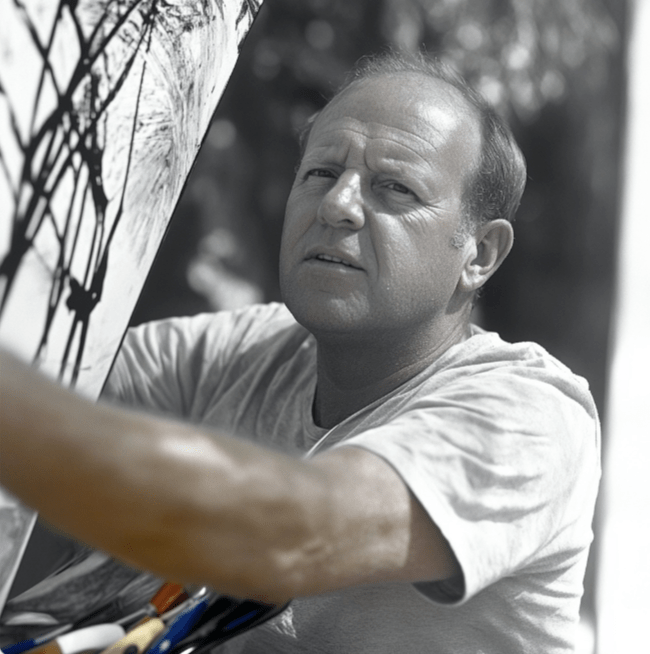Exploring Abstract Expressionism: Key Abstract Expressionist Artists
What is Abstract Expressionism and Its Influence on Art History?
How did Abstract Expressionism begin and who were its pioneers?
The origins of Abstract Expressionism can be traced back to the early 1940s in New York City, a hub of artistic innovation and experimentation. This movement was pioneered by a group of American painters who sought to express their innermost emotions through abstract art. Influences from European Surrealism and the emotional intensity of Expressionism fused together, giving birth to a new and dynamic art form. Artists such as Arshile Gorky, who brought his own expressive style to the canvas, played a critical role in laying the groundwork for what would become a defining moment in the timeline of art history. Gorky's emotional depictions and use of abstraction paved the way for a generation of abstract expressionist artists who would continue to evolve the movement.
What role did the New York School play in the development of Abstract Expressionism?
The New York School was instrumental in the development and prominence of Abstract Expressionism. This informal group of artists, including figures like Jackson Pollock, Willem de Kooning, and Franz Kline, gathered in New York City and became known for their abstract expressionist works. They embraced the idea of painting as an action, focusing on the process and the expressive potential of the medium rather than a finished product. Their collaboration and exchange of ideas fostered an environment of creativity and innovation, cementing New York City's status as a new epicenter for modern art. The New York School's influence extended far beyond American art, impacting artists around the world and encouraging the spread of abstract painting techniques.
How did Abstract Expressionism influence other art movements?
Abstract Expressionism had a profound influence on subsequent art movements and continues to inspire contemporary artists today. Its emphasis on freedom of expression and breaking away from traditional artistic constraints paved the way for movements such as Minimalism and Conceptual Art. Abstract Expressionism's gestural techniques and expressive use of color were precursors to the development of color field painting, an art form that simplified compositions to focus on large areas of a single color. Artists like Mark Rothko and Barnett Newman were pivotal in this transition, using expansive canvases to evoke emotional responses. The movement's legacy is evident in the works of later abstract artists who continue to explore the emotional and psychological dimensions of art.
Who Were the Key Abstract Expressionist Artists?
How did Jackson Pollock revolutionize the art world with his drip technique?
Jackson Pollock is perhaps the most famous abstract expressionist painter, known for his revolutionary drip technique that transformed the art world. By laying his canvas on the floor and applying paint with dynamic gestures, Pollock created a unique visual language that emphasized movement and chaos. His approach liberated artists from the confines of the easel, allowing them to engage with their work in a physical and direct manner. Pollock's paintings, characterized by their intricate networks of drips and splatters, conveyed a sense of spontaneity and energy that resonated with viewers and challenged traditional notions of composition and form. His innovative techniques cemented his status as a pioneer of the abstract expressionist movement.
What contributions did Willem de Kooning make to Abstract Expressionism?
Willem de Kooning was a central figure in Abstract Expressionism, known for his bold brushwork and dynamic compositions. His work often blurred the lines between abstraction and representation, as he explored themes of the human figure with an expressive vigor. De Kooning’s paintings, marked by their gestural brushstrokes and vibrant colors, reflected his commitment to exploring the complexities of human emotion and form. His series of Women paintings exemplified his ability to merge figuration with abstraction, creating works that were both provocative and deeply expressive. De Kooning's contributions to the movement were significant, as he pushed the boundaries of painting and inspired a generation of artists to embrace abstraction.
How did Mark Rothko's color field paintings impact the movement?
Mark Rothko, a prominent figure in the color field painting style, made significant contributions to Abstract Expressionism through his exploration of color and form. Rothko's large-scale canvases, characterized by their luminous blocks of color, sought to evoke emotional responses in viewers. His approach to painting was deeply spiritual, focusing on the power of color to convey profound emotions and transcendental experiences. Rothko believed that art should be a means of communication, capable of expressing universal human experiences. His work had a lasting impact on the movement, influencing artists who sought to explore the psychological and emotional dimensions of color and abstraction.
How Did Female Artists Shape Abstract Expressionism?
What was Lee Krasner's role in the Abstract Expressionist movement?
Lee Krasner was a pioneering female artist within the Abstract Expressionist movement, known for her innovative approaches to composition and form. As an accomplished painter in her own right, Krasner's work was characterized by its bold use of color and dynamic compositions. She played a crucial role in the movement, contributing to the development of abstract painting with her unique artistic vision. Despite often being overshadowed by her husband, Jackson Pollock, Krasner's contributions were significant, and her work has been increasingly recognized for its originality and influence. Her ability to constantly reinvent her style and push the boundaries of abstraction made her a vital figure in the art world.
How did Helen Frankenthaler contribute to the color field painting style?
Helen Frankenthaler was a leading figure in the development of the color field painting style, known for her innovative use of color and technique. Her breakthrough came with the creation of the soak-stain method, where she applied thinned paint to raw canvas, allowing it to soak into the fibers and create soft, luminous color fields. This approach marked a departure from the gestural techniques of her contemporaries and paved the way for future developments in color field painting. Frankenthaler's work was celebrated for its lyrical and atmospheric qualities, and she played a pivotal role in expanding the possibilities of abstract expressionist art through her exploration of color and form.
What influence did Joan Mitchell have on the art movement?
Joan Mitchell was a prominent figure in Abstract Expressionism, known for her emotive and powerful paintings. Her work was characterized by its intense energy and vibrant color, often drawing inspiration from nature and personal experiences. Mitchell's paintings were both gestural and lyrical, capturing the dynamic interplay of color and form. As a female artist in a predominantly male-dominated art movement, Mitchell's success and influence were significant, and she helped pave the way for future generations of women artists. Her contributions to the movement were marked by a commitment to exploring the emotional and expressive potential of abstract art, making her a key figure in its development.
What are the Different Styles Within Abstract Expressionism?
How do action painting and gestural techniques differ?
Action painting and gestural techniques are two key styles within Abstract Expressionism that emphasize the physical act of painting as an essential component of the creative process. Action painting, exemplified by artists like Jackson Pollock, focuses on the spontaneous application of paint through dripping, pouring, or splattering, emphasizing the artist's physical engagement with the canvas. This approach highlights the dynamic and energetic nature of the creative process, with the resulting work capturing the immediacy of the artist’s actions. In contrast, gestural techniques involve more deliberate brushwork, where the movement of the artist's hand is evident in the expressive strokes on the canvas. Artists like Willem de Kooning utilized gestural techniques to convey emotion and movement, creating compositions that were both structured and spontaneous. While both styles emphasize the physicality of painting, they differ in their approach to composition and the degree of control exercised by the artist.
What is the significance of color field painting in Abstract Expressionism?
Color field painting is a significant style within Abstract Expressionism that focuses on the use of large expanses of color to create a meditative and immersive experience for the viewer. Artists like Mark Rothko and Barnett Newman were pioneers of this style, using simple compositions and vibrant colors to evoke emotional and spiritual responses. Unlike the dynamic energy of action painting, color field painting emphasizes stillness and contemplation, inviting viewers to engage with the subtleties of color and form. This approach to painting marked a shift towards minimalism and abstraction, influencing subsequent movements and challenging traditional notions of composition and representation. The significance of color field painting lies in its ability to convey profound emotional experiences through the power of color alone, making it a pivotal development in the evolution of abstract art.
How did artists like Clyfford Still and Barnett Newman define their styles?
Clyfford Still and Barnett Newman were influential figures in Abstract Expressionism, each developing a distinctive style that contributed to the movement's diversity. Clyfford Still's work was characterized by its bold, jagged forms and dramatic contrasts of color, creating compositions that were both dynamic and monumental. His paintings often evoked a sense of grandeur and intensity, reflecting his belief in the transformative power of art. Barnett Newman, on the other hand, was known for his minimalist approach and use of color fields, with his iconic "zip" paintings featuring vertical bands of color that divided the canvas. Newman's work emphasized simplicity and purity of form, aiming to evoke a sense of transcendence and spiritual contemplation. Both artists played a crucial role in defining the stylistic boundaries of Abstract Expressionism, pushing the movement towards new and innovative directions.
What is the Legacy of Abstract Expressionism Today?
How is Abstract Expressionism viewed in contemporary art circles?
In contemporary art circles, Abstract Expressionism is viewed as a seminal movement that continues to influence artists and shape the discourse around modern art. Its emphasis on emotional expression and the exploration of the subconscious has had a lasting impact on contemporary artists who seek to push the boundaries of abstraction. Abstract Expressionism's legacy is evident in the works of contemporary painters who continue to explore the possibilities of gesture, color, and form. The movement's influence can be seen in the ongoing dialogue between tradition and innovation, as artists draw inspiration from the past while forging new paths in the art world. Abstract Expressionism remains a vital reference point for understanding the evolution of modern art and its continued relevance in the contemporary art scene.
What are the lasting impacts of Abstract Expressionism on modern painting?
The lasting impacts of Abstract Expressionism on modern painting are profound and far-reaching. The movement's emphasis on spontaneity, emotion, and the physical act of painting revolutionized the way artists approached their craft, encouraging an exploration of new techniques and materials. Abstract Expressionism's influence can be seen in the development of subsequent art movements, such as Minimalism and Conceptual Art, which built upon its ideas of abstraction and expression. The movement also paved the way for a more inclusive and diverse art scene, as it challenged traditional hierarchies and opened up new possibilities for artistic expression. Abstract Expressionism's legacy is evident in the continued exploration of abstraction and the enduring appeal of its bold and expressive style.
How do museums like the Guggenheim preserve Abstract Expressionist works?
Museums like the Guggenheim play a crucial role in preserving and showcasing Abstract Expressionist works, ensuring that the movement's legacy continues to inspire future generations. These institutions house extensive collections of abstract expressionist paintings, providing a platform for scholars, artists, and the public to engage with the movement's rich history and artistic achievements. The Guggenheim, along with other esteemed institutions like the Museum of Modern Art and the Metropolitan Museum of Art, organizes exhibitions and educational programs that highlight the contributions of key abstract expressionist artists. By preserving these works and promoting their study, museums help to maintain the relevance and significance of Abstract Expressionism in the broader context of art history. Their efforts ensure that the movement's impact on the art world remains a vital part of the ongoing dialogue about modern art and its evolution.
Enhance Your Space with Unique Modern Masterpieces
Are you inspired by the innovative mediums and conceptual depth highlighted in our exploration of contemporary art? You’re not alone! Today’s art enthusiasts are seeking cultural relevance and emotional connections in their artwork. However, finding pieces that resonate with modern themes and fit your unique style can be a challenge. That’s where we come in!
At Rossetti Art, we specialize in canvas prints, original paintings, and modern sculptures that celebrate the spirit of now. Each piece created by Chiara Rossetti brings a personal touch that connects deeply with current social narratives—just like the modern masterpieces discussed in the article. Don’t miss out on the chance to elevate your home decor with breathtaking artwork that speaks to your values and aesthetic. Explore our collection today and find your perfect piece! Act now, and transform your space into a gallery of inspiration!
FAQ
Q: Who are some key artists associated with Abstract Expressionism?
A: Key artists associated with Abstract Expressionism include Jackson Pollock, Mark Rothko, Lee Krasner, Robert Motherwell, and Arshile Gorky. These artists were part of the first-generation abstract expressionist movement, creating works that emphasized spontaneity and emotional intensity.
Q: What is the difference between Action Painters and Color Field Painters?
A: Action Painters, like Jackson Pollock, focused on the physical act of painting, emphasizing dynamic brushstrokes and gestures. Color Field Painters, such as Mark Rothko, concentrated on large areas of color and the emotional resonance of color itself. Both styles are integral to Abstract Expressionism.
Q: How did Robert Motherwell contribute to Abstract Expressionism?
A: Robert Motherwell was an influential artist in the Abstract Expressionist movement. He was known for his use of bold colors and abstract forms, and he played a significant role in bringing attention to the movement as an art critic and theorist.
Q: What role did women play in Abstract Expressionism?
A: Women of Abstract Expressionism, such as Lee Krasner and Joan Mitchell, played crucial roles in the movement. Despite facing significant challenges in a male-dominated art world, these artists made significant contributions with their unique styles and perspectives.
Q: What is the significance of the New York School in Abstract Expressionism?
A: The New York School refers to a group of artists working in New York City during the 1940s and 1950s who were central to the development of Abstract Expressionism. This group included prominent figures like Jackson Pollock and Willem de Kooning, and their work had a profound influence on the direction of modern art.
Q: How did art critics and historians view Abstract Expressionism?
A: Art critics and historians initially had mixed views on Abstract Expressionism. While some praised its innovation and emotional depth, others criticized its perceived lack of structure. Over time, it has gained widespread recognition as a pivotal movement in modern art history.
Q: What influence did Arshile Gorky have on Abstract Expressionism?
A: Arshile Gorky is considered a precursor to Abstract Expressionism. His work combined elements of surrealism and abstraction, influencing many other artists associated with abstract expressionism, including Willem de Kooning and Jackson Pollock.
Q: Can you explain the timeline of Abstract Expressionism within art history?
A: Abstract Expressionism emerged in the late 1940s and became the dominant art movement in the 1950s. It was primarily centered in New York, marking a shift in the art world's focus from Europe to America. By the 1960s, it had paved the way for subsequent movements like Minimalism and Pop Art.
Q: How did American artists influence the development of Abstract Expressionism?
A: American artists, particularly those in the New York School, were instrumental in developing Abstract Expressionism. They drew inspiration from European modernism but forged a distinctly American style characterized by emotional intensity and an impression of spontaneity.
Q: What is the legacy of Abstract Expressionism today?
A: The legacy of Abstract Expressionism is seen in its profound impact on modern art. It shifted the art world's focus to New York, influenced numerous subsequent movements, and continues to inspire artists and art historians with its innovative approaches to form and expression.





Leave a comment
This site is protected by hCaptcha and the hCaptcha Privacy Policy and Terms of Service apply.